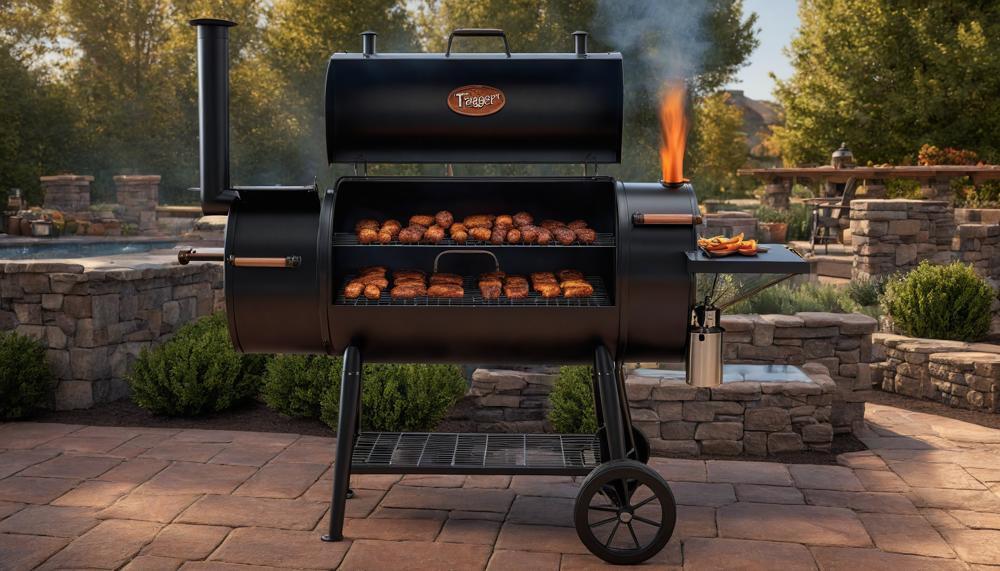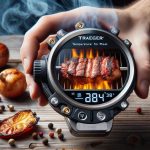Ever set up your Traeger smoker for a perfect cookout, only to find it refusing to get hot? Frustrating, right? A cold Traeger can be a major bummer, especially when you’ve got a meal to prepare. But don’t worry, you’re not alone in this smoky struggle.
Several common culprits could be causing your Traeger to underperform, from pellet problems to weather woes. Understanding these issues is the first step to getting your grill back to its sizzling best.
Here are some key points to consider:
- Pellet Quality: Wet, old, or low-quality pellets can hinder your grill’s heating performance.
- Startup and Shutdown Procedures: Incorrect processes can lead to heating issues, especially on WiFIRE or AC models.
- Maintenance: Regular cleaning and upkeep are crucial for optimal grill performance.
- Power Supply: Insufficient or inconsistent power can affect heating.
- Weather Conditions: Cold or windy weather can impact your grill’s ability to reach high temperatures.
- RTD Probe: A dirty or faulty temperature probe can cause inaccurate readings and heating problems.
- Auger Jams: Blockages in the pellet feed system can prevent your grill from heating up.
By identifying and addressing these common issues, you can ensure your Traeger smoker is always ready to deliver delicious, smoky goodness. Let’s dive into the details and get your grill back on track.
Contents
Hot Rod Deterioration
A deteriorating hot rod in your Traeger smoker can severely impact its heating capabilities. The hot rod is responsible for igniting the wood pellets, which are essential for generating heat. If the hot rod is failing, it may not heat the pellets sufficiently, resulting in the smoker not reaching or maintaining the desired temperature.
This malfunction can lead to inconsistent cooking results, longer cooking times, and potential safety hazards if the pellets do not ignite properly.
The following table summarises the potential effects of a deteriorating hot rod:
| Issue | Effect on Heating | Solution |
| Hot Rod Failing to Ignite Pellets | Smoker fails to reach desired temperature | Replace the hot rod |
| Inconsistent Heating | Uneven cooking and longer cook times | Ensure proper maintenance and replace faulty parts |
| Potential Safety Hazards | Incomplete pellet ignition may pose fire risks | Regularly inspect and maintain the hot rod |
Common Symptoms of a Deteriorating Hot Rod:
- Slow Heating: The smoker takes longer than usual to heat up.
- Error Codes: Your Traeger might display error codes related to ignition failures.
- Inconsistent Temperatures: Fluctuating temperatures during cooking sessions.
- Unburned Pellets: A pile of unburned pellets in the firepot.
Maintenance Tips:
- Regular Inspection: Periodically check the hot rod for signs of wear and tear.
- Replacement: Consider replacing the hot rod if it’s over a year old or showing signs of damage. You can purchase replacement hot rods from Traeger or other reputable online vendors.
- Proper Start-Up/Shut-Down: Follow the recommended procedures for starting and shutting down your Traeger to prevent undue stress on the hot rod.
Low-Quality Pellets
Low-quality pellets can significantly affect the heating performance of a Traeger smoker. These pellets produce excessive ash due to inefficient burning. The accumulation of ash can smother the hot rod in the fire pot, obstructing airflow and combustion, which reduces heat output.
This not only affects the consistency of the cooking temperature but can also cause the fire to extinguish unexpectedly. To maintain optimal performance, it is recommended to use high-quality pellets specifically designed for pellet grills.
| Issue | Effect on Heating Performance | Solution |
| Excessive Ash Production | Ash build-up covers the hot rod, reducing heat output and potentially causing the fire to go out. | Use high-quality pellets designed for pellet grills. |
| Obstructed Airflow | Improper airflow hampers combustion, leading to inconsistent temperatures. | Regularly clean the fire pot and use quality pellets. |
| Inconsistent Combustion | Unreliable heating performance results in uneven cooking. | Ensure pellets are of good quality to promote efficient burning. |
Using high-quality pellets not only ensures a steady heat output but also minimizes maintenance efforts. By choosing the right pellets, you enhance your Traeger smoker’s performance and ensure a better cooking experience.
Not Enough Pellets in the Grill
You can tell if there are not enough pellets in your Traeger smoker by observing temperature drops and inspecting the hopper. If the smoker struggles to reach or maintain the set temperature, it’s often a sign of insufficient pellets. Another clue is a low or empty hopper, as the smoker relies on a steady supply of pellets to sustain the fire.
To fix this issue and get your grill hotter, follow these steps:
- Refill the Hopper: Check the pellet level and refill if necessary. Keep extra bags of wood pellets on hand to ensure you never run out during a cook.
- Monitor Pellet Usage: Periodically check the hopper during long cooking sessions to ensure it has enough pellets. An 18 lb hopper should generally last around 20 hours, but this can vary based on cooking temperature and weather conditions.
- Adjust the P-Setting: Increase the P-setting to feed more pellets into the firepot, raising the temperature. Be cautious not to set it too high, which could cause safety issues or damage to the smoker.
- Use High-Quality Pellets: Low-quality pellets can produce excessive ash, affecting heat production. Use high-quality pellets designed for pellet grills to ensure efficient burning and consistent temperature.
- Clean the Grill: Regularly clean the firepot and other components to prevent ash buildup, which can impede airflow and reduce temperature.
Blown Fuses
When dealing with blown fuses in your Traeger smoker, several common culprits might be at play. Understanding these issues and knowing how to address them can save you a lot of hassle and ensure your smoker works flawlessly.
Common Reasons for Blown Fuses
- Loose Power Cord: A loose or improperly connected power cord can cause intermittent power issues, leading to blown fuses.
- Damaged Hot Rod: The hot rod igniter, if damaged or shorted, can draw excessive current, blowing the fuse.
- Malfunctioning Auger Motor: The auger motor, responsible for feeding pellets into the firepot, may malfunction or draw too much power, resulting in a blown fuse.
Prevention and Fixes
To prevent or fix these issues, follow these steps:
| Issue | Prevention | Fix |
| Loose Power Cord | Regularly check the power cord for secure connection. | Ensure the power cord is firmly plugged in and free of visible damage. |
| Damaged Hot Rod | Inspect the hot rod periodically for wear and tear. | Turn off the Traeger, disconnect the hot rod, and replace it if damaged. |
| Malfunctioning Auger Motor | Keep the auger motor clean and free of pellet dust. | Disconnect the auger motor and inspect for signs of damage or excessive wear. Replace if necessary. |
Detailed Steps to Fix Blown Fuses
- Turn Off the Traeger: Always start by turning off your Traeger to prevent any electrical hazards.
- Inspect the Hot Rod: Disconnect and examine the hot rod for any signs of damage or shorts. Replace if necessary.
- Check the Auger Motor: Disconnect the auger motor and inspect it. A malfunctioning motor may need cleaning or replacement.
- Examine the Power Cord: Ensure the power cord is securely connected and free from damage. Replace if frayed or damaged.
- Reconnect All Wiring: After inspecting and addressing any issues, reconnect all wiring securely.
- Test the Traeger: Turn the Traeger back on and test to see if the issue is resolved.
Regular maintenance is key to preventing blown fuses. By routinely checking and addressing these potential issues, you can ensure your Traeger smoker operates smoothly and avoids unnecessary disruptions.
Too Much Debris in the Firepot
Cleaning the firepot on your Traeger smoker is essential to maintain efficient heat distribution and prevent debris build-up. Follow these steps for an effective clean:
Frequency of Cleaning
:
- Clean the firepot deeply 1-2 times a year to keep your smoker in top condition.
Tools and Materials
:
- Shop-Vac: Essential for vacuuming out ash and debris.
- Traeger All-Natural Cleaner: For cleaning other parts of the smoker.
- Paper Towels: For wiping down surfaces.
Cleaning Steps
:
- Prepare the Smoker: Ensure the smoker is off and cool before starting.
- Vacuum the Firepot: Use a shop-vac to remove ash and debris from the firepot. Do this while the smoker is warm, but not hot, to make ash removal easier. Be careful not to introduce any liquid cleaner into the firepot.
- Clean Surrounding Areas: Unscrew the chimney cap and use Traeger cleaner and paper towels to wipe down the inside of the chimney. Also, clean the grease drip tray by spraying with cleaner and scrubbing with paper towels.
Additional Tips
:
- Avoid using liquid cleaners inside the firepot to prevent any potential damage or residue build-up.
- Regularly check and clean the grates and other parts of the smoker to ensure overall maintenance.
Moisture in the Grill
Moisture plays a significant role in the heating dynamics of a Traeger smoker. When moisture levels inside the grill are high, it affects both the combustion of the wood pellets and the temperature stability. Here’s a detailed analysis:
Moisture Impact on Combustion and Temperature:
- Pellet Efficiency: High moisture content in the pellets can hinder their ability to burn efficiently, leading to lower heat output. This inefficiency can cause the smoker to struggle to reach or maintain the desired cooking temperature.
- Heat Retention: Moisture in the grill chamber can cause fluctuations in temperature as the water absorbs heat energy. This absorption can lead to slower heating times and difficulty in maintaining a steady temperature, crucial for low and slow cooking.
- Smoke Production: Moisture can affect the quality of smoke produced. Wet pellets or a damp firepot may generate more steam than smoke, impacting the smoky flavor that defines Traeger-cooked dishes.
- Grill Components: Excess moisture can cause rusting and damage to the internal components of the grill, such as the firepot and auger. This degradation can impact the grill’s performance and longevity.
Broken Induction Fan
A broken induction fan significantly impairs the heating capabilities of a Traeger smoker. This component regulates temperature by circulating air, ensuring even heat distribution across the grill. When the induction fan malfunctions, several issues arise:
| Issue | Impact | Details |
| Uneven Heating | Hot and Cold Zones | One side of the grill becomes hotter while the other remains cold, leading to inconsistent cooking results. |
| Temperature Fluctuations | Inconsistent Temperatures | The smoker may swing between being too cold and having short bursts of intense heat, making it difficult to maintain a stable cooking temperature. |
| Reduced Smoke Production | Less Flavor | Improper air circulation affects the combustion of pellets, resulting in inadequate smoke production, which diminishes the flavor of the food. |
| Component Strain | Potential Damage | Other components, like the auger and heating element, may experience increased wear and tear due to irregular operation, potentially leading to further malfunctions. |

To mitigate these problems, it’s crucial to ensure your induction fan is functioning correctly. If you suspect it’s broken, consult your Traeger manual or seek professional repair services.
To find information about why your Traeger smoker is not getting hot, follow these steps here:
| Step | Action | Details |
| 1 | Visit “Troubleshooting” Category | Find posts addressing common issues, including heating problems. |
| 2 | Use Search Bar | Type “Traeger smoker not getting hot” to locate relevant posts quickly. |
| 3 | Check Related Posts | At the end of each post, find additional articles that may help. |
| 4 | Engage in Comments | Leave questions or comments for expert and community advice. |
By following these steps, you should be able to navigate our blog efficiently and find the specific information you need to address your Traeger smoker’s heating issues.
Conclusion
In conclusion, addressing the heating issues of your Traeger smoker involves a multi-faceted approach. Ensuring pellet quality is paramount—wet, old, or low-grade pellets can significantly hinder performance. Following proper startup and shutdown procedures, particularly for WiFIRE or AC models, prevents operational errors. Consistent maintenance, including regular cleaning of the firepot and inspection of the hot rod, auger motor, and power cord, is crucial for optimal performance and safety.
Environmental factors like cold or windy weather can also impact your grill’s ability to heat up. Protect your smoker and maintain a steady supply of dry, high-quality pellets to counteract these conditions. Finally, regularly check the RTD probe for accuracy and cleanliness to avoid misleading temperature readings.






